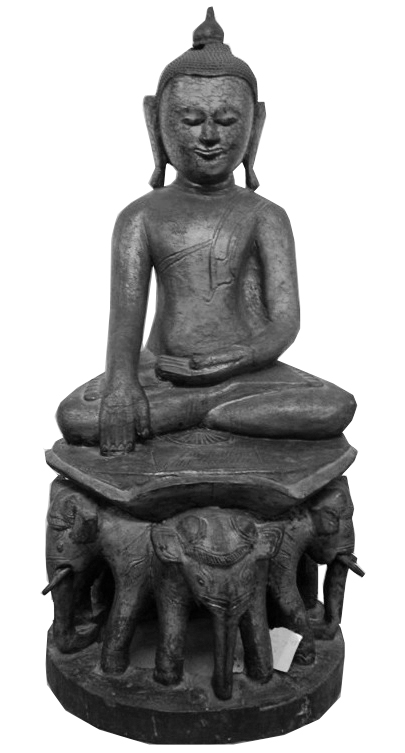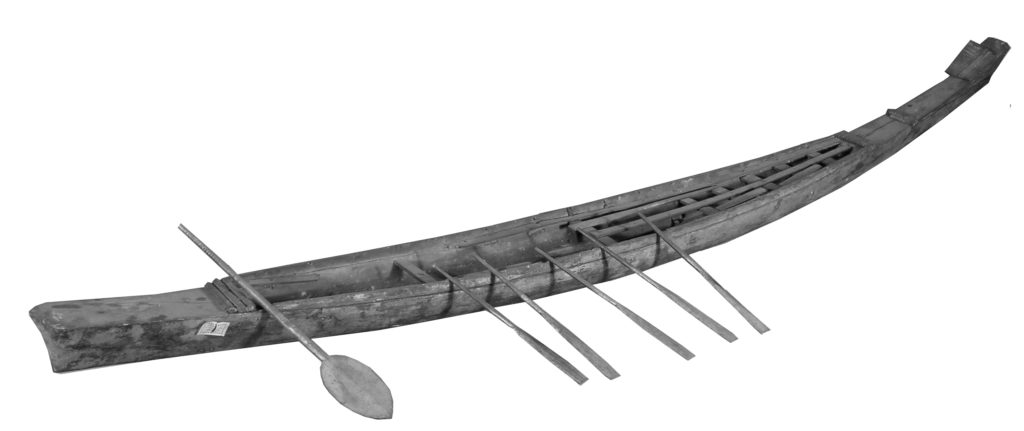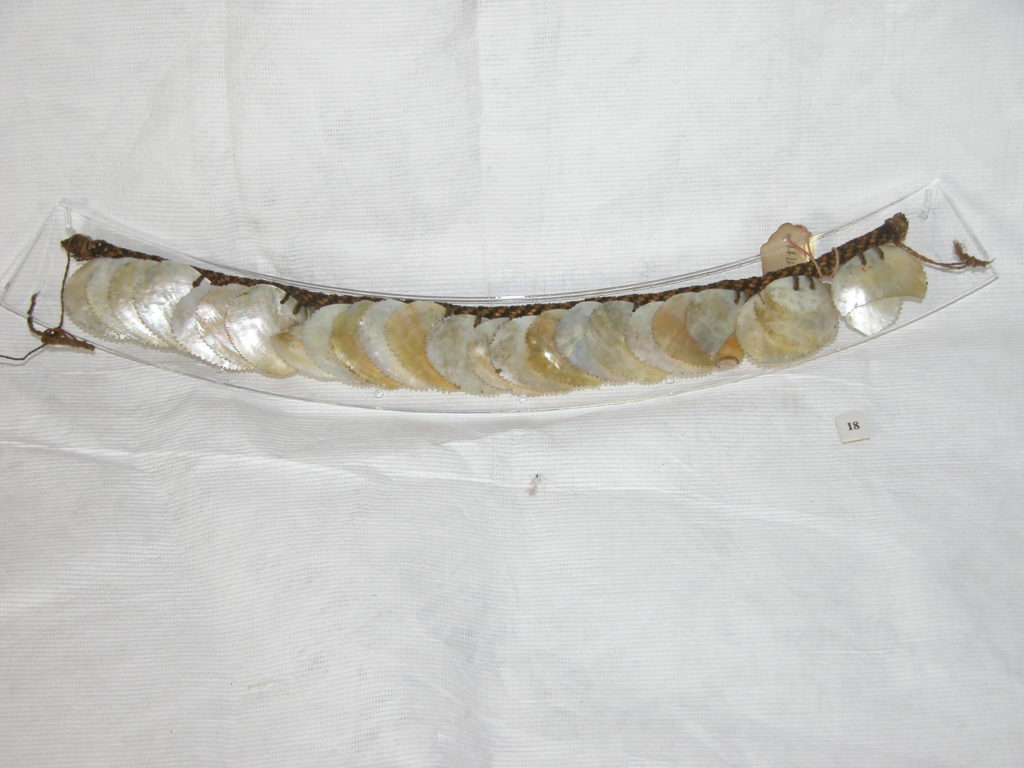
Aboriginal hammers
Early to mid-19th century
Stone, wood and gum
These are practical tools made from local materials. The stones are fixed to the wooden handles with gum from trees.
Reference: 4480, 4481, 4482
Can be found: Travellers to the Pacific, Australasia and America

African dagger in scabbard
18th to early 19th century; Fernando Po, West Africa
Wood and metal
Small dagger in gold-covered scabbard collected in 1821-26.
Presented by Captain Thomas Boteler, RN, to Canterbury Philosophical and Literary Institution Museum, 1827-28, and acquired through purchase of the Museum by Canterbury Corporation, 1846-47
Reference: 4613
Can be found: Africa, Asia, America, Pacific

African dagger in scabbard 18th to early 19th century; Fernando Po, West Africa
Wood and metal
Small dagger in gold-covered scabbard collected in 1821-26.
Presented by Captain Thomas Boteler, RN, to Canterbury Philosophical and Literary Institution Museum, 1827-28, and acquired through purchase of the Museum by Canterbury Corporation, 1846-47
Reference: 4612
Can be found: Africa, Asia, America, Pacific

African hair pin
19th century
Bone
This hair pin has four long prongs and a spoon-shaped handle, which has been described as a snuff ladle.
Reference: 4633
Can be found: Africa, Asia, America, Pacific

African headrests
19th century; Ashanti, Ghana
Painted wood
The smaller headrest is typical of the Ashanti people in the former Gold Coast, now Ghana. It is decorated with a wash of blue pigment. The larger headrest follows the Ghanaian shape but has elements of southeast African decoration. Cross-cultural styles like this were used in South Africa. The original black paint has worn with use.
Headrests were used by African men of fairly high status and were significant personal objects, protecting the owner’s head and hairstyle.
Reference: 4508, 4509
Can be found: Africa, Asia, America, Pacific

African sculpture, Qur’anic board, cap and gourds
20th century; Yoruba, Hausa and Ashanti peoples, Nigeria and Ghana
Wood and bronze
Two of the Yoruba sculptures are ritual ‘deceased-twin substitute’ carvings. The third is a small figure with distinctive hairstyle. Such African sculptures, with bold abstract features, have had a huge influence on modern artists. The doll is Ashanti from Ghana and would be carried by a pregnant woman to promote beauty in her unborn child.
Ghana is a centre of gold mining and the Ashanti are best known for their intricate tiny brass sculptures used to weigh gold. Dried and decorated gourd rinds are from the Hausa people, northern Nigeria, as is the Qur’anic writing board of the Hausa people has been decorated to celebrate a pupil’s achievement at school, and the embroidered cap.
Lent by Dr David Heathcote, 2012
Reference: CANCM:nn
Can be found: Africa, Asia, America, Pacific

African spear and shield
19th century; Mahdi people, Sudan
Wood, metal, animal hide
Captain J Graham brought back three spearheads and two spears described as ‘small’ but with shafts so long they had to be broken for transport. One spearhead was said to have belonged to the Khalifa, the Mahdi’s successor.
Collected by Captain J. Graham, 1898, and presented by General Sir James Graham, KCB, 1902
Reference: 3007, 3009
Can be found: Africa, Asia, America, Pacific

African sword
19th century; Akan Gold Coast (Ghana)
Metal and wood
The weapon with double-balled handle and openwork decoration on the blade is from the Akan area of the Gold Coast and probably an Ashanti sword.
Probably presented by Captain Thomas Boteler, RN, to Canterbury Philosophical and Literary Institution Museum, 1828, and acquired through purchase of the Museum by Canterbury Corporation, 1846-47
Reference: CANCM:nn
Can be found: Africa, Asia, America, Pacific

African sword
19th century; Congo
Metal and wood
This is a Congo ceremonial sword used among the Ngombe, Ngbandi and Lokele peoples.
Probably presented by Captain Thomas Boteler, RN, to Canterbury Philosophical and Literary Institution Museum, 1828, and acquired through purchase of the Museum by Canterbury Corporation, 1846-47
Reference: CANCM:nn
Can be found: Africa, Asia, America, Pacific

African sword and scabbard
19th century; Mahdi people, Sudan
Metal and wood
A souvenir with broken blade. It belonged to a fighter in the Islamic Mahdi army massacred by British troops.
Collected by Captain J Graham, 1898, and presented by General Sir James Graham, KCB, 1902
Reference: 3004
Can be found: Africa, Asia, America, Pacific

African water pot and water juj
20th century; Hausa people, Northern Nigeria
Earthenware, gourd rind
The pot was formed by pressing clay into an earthen hollow, making two half-rounds then joining them together and smoothing by hand. It sits on a ring when carried on the head. The jug is used for washing before entering a mosque.
Lent by Dr David Heathcote, 2012
Reference: CANCM:nn
Can be found: Africa, Asia, America, Pacific

Bark cloth
19th century; South Sea Islands
Bark
Reference: 4590
Can be found: Travellers to the Pacific, Australasia and America

Buddha seated on elephants
19th century; Burma
Bronze-covered wood
In Buddhism the elephant symbolises strength of mind, embodying calm majesty and noble gentleness. This Buddha has the hands arranged in ‘touching the earth’ pose.
Presented by Miss Mona Sharp,1908
Reference: 4864
Can be found: Travellers to the East

Buddhas
19th century; Thailand
Silver-covered wax, Alabaster
The silver Buddhas are posed in the attitude of meditation. The carved alabaster Buddha, in ‘touching the earth’ pose, has small wings. All are probably from domestic shrines.
Reference: 1756, 126, 1751, 1752
Can be found: Travellers to the East

Cast of part of a Mastodon andium lower jaw
1845 copy of prehistoric original
Plaster
This is a cast of the fossilised jaw found in South America and given to Canterbury Philosophical and Literary Institution Museum in 1841 by General William Miller. The original was lent to the British Museum in 1845, when it was used to help establish the new species of elephant ancestor Mastodon andium. Canterbury Curator John Brent allowed the British Museum to keep the original in exchange for a cast and various other fossil specimens.
Presented by William Miller to Canterbury Philosophical and Literary Institution Museum and acquired through purchase of the Museum by Canterbury Corporation, 1846-47
Reference: A160
Can be found: Travellers to the Pacific, Australasia and America

Chinese ceramic temple
19th century; Shiwan in Guangdong province, China
Glazed earthenware
This building is modelled on a Shenist folk temple to nature gods and patron gods. The Chinese text on the pillars can be translated as ‘Fiction or reality, we revisit our ancestors with these figures’.
It was probably made at a workshop called Rui Yuan in Shiwan, Fo Shan City, Guangdong province, a well-known centre for ceramics production of this type. The ceramic used is known as stoneware because of its durability. Shiwan was famous for making architectural ceramics and ceramic figures during the Ming and Qing dynasties (14th to early 20th centuries).
Presented by Mr W Welby, 1874
Reference: 125
Can be found: Travellers to the East

Chinese pagoda model
19th to 20th century
Ivory
Pagodas are tiered buildings in Asia, originally with a religious function and often sited near temples. The word ‘pagoda’ comes from the Portuguese pagode, meaning ‘temple’.
Reference: 1750A
Can be found: Travellers to the East

Chinese shoes and purse 19th to 20th century
Silk and wood
The purse has a drawstring moneybag inside the eggshell-like segments, which are held together by tassels. The child’s shoe was given to the museum with a stone inside to keep its shape. Embroidered shoes displayed on the right have a raised sole to keep the embroidered fabric above dust and dirt on the ground.
Child’s shoe conserved with grant-aid from the Kathy Callow Trust, 2012; purse presented by Mrs F. Brewster, 1905
Reference: 4710, (nn), 4757
Can be found: Travellers to the East

Clubs from Nootka Sound
Late 18th century; Nootka Sound, Vancouver Island, Canada
Whalebone
The form and decoration of these clubs is unique to people from Nootka Sound. One has a serpent-head handle unlike any other clubs so far recorded. They were collected during Captain Cook’s voyages in 1776-79.
Reference: 4476, 4477
Can be found: Travellers to the Pacific, Australasia and America

Coconut cup
19th century; Polynesia
Coconut shell
The coconut cup would have been used for fermented drinks. It is a high status item with decorations linked to the Cook Islands.
Reference: CANCM:nn
Can be found: Travellers to the Pacific, Australasia and America

Coir comb
18th to 19th century; Tonga, South Seas Coir
The decorative hair comb from Tonga is made of coir fibres.
Reference: 1763
Can be found: Travellers to the Pacific, Australasia and America

Decoration from a Burmese building
19th century; probably Mandalay, Burma
Wood and gold leaf
19th century; probably Mandalay, Burma Wood and gold leaf
This is one of several souvenirs brought back from Burma after British forces overthrew King Thibaw in 1885. His palace in Mandalay was ransacked and its decorations, including this panel, dismantled.
Presented by Miss Mona Sharp, 1908
Reference: 4867
Can be found: Travellers to the East

Lime gourd
19th century; Solomon Islands
Gourd rind
The gourd was used for burning coral to create lime, which was chewed with beetle leaves.
Reference: CANCM:nn
Can be found: Travellers to the Pacific, Australasia and America

Model of a Chinese junk
19th century; China
Wood and textile
The junk is a traditional South-East Asian boat. Each shipyard builds junks in a slightly different way so there are many varied types. Models like this were made for international exhibition.
Presented by Major C Lefevre, OBE, 1945
Reference: CANCM:nn
Can be found: Travellers to the East

Model of a Malay house
19th-20th century; Malaysia
Wood
This is a faithful model of a house built on stilts, near water or in areas subject to flooding. The roof tiles are of finely split wood planks.
Presented by Rev. F. Payler Woodward, 1914
Reference: L239
Can be found: Travellers to the East

Model of a South-East Asian canoe
19th to 20th century; probably from Burma Wood
Like the Chinese junk, this model of a canoe is made with care to detail of the oars, planks and construction of the full-size equivalent.
Reference: 4522
Can be found: Travellers to the East

Shell necklace
18th to 19th century; Tahiti, South Seas
Shells and fibres
Pearl shells for the necklace have been carefully serrated round the edges and bound with pandanus (aromatic plant) leaves, hibiscus string and dyed black fibres.
Reference: 4451
Can be found: Travellers to the Pacific, Australasia and America

Shield from Borneo
19th to 20th century; Borneo
Wood and cane
A shield carved with an integral handle on the reverse from the same piece of wood. Split cane has been added during construction for strength.
Presented by Lady Mitchell, 1907
Reference: 4843
Can be found: Travellers to the East

Snowshoe
Early to mid-19th century; Central North Canada
Wood, animal gut, cloth
One of a pair of snowshoes used by animal trappers and made from local materials except for the cloth, which probably came from Stroud in Gloucestershire, which had trading links with Canadian trappers.
Reference: 4513
Can be found: Travellers to the Pacific, Australasia and America

South Seas clubs
Late 18th to mid 19th century; New Zealand and Fiji
Stone, Root ball
A Maori stone club and a throwing club from Fiji, both of them for use, not decoration.
Reference: 4473, 4490
Can be found: Travellers to the Pacific, Australasia and America

South Seas fishhooks and cloak pins
19th century; New Zealand, Tahiti and Hawaii
Bone, shell and twine
People living in the South Seas have created a large range of different fishhooks, each suited to catching a particular type of fish.
Reference: 4462, 4463k
Can be found: Travellers to the Pacific, Australasia and America

South Seas paddles and scoop
19th century; Ra’ivavae, Austral Islands
Wood
These paddles and scoop date from about 1815 to 1840. They are for decoration rather than practical use and were originally made for local trade. As the South Seas opened up to visitors from the west, the decorative paddles became much sought-after collectors’ items among Europeans.
They were made on one island, Ra’ivavae, but some were traded to Taluh, another island, and acquired from there. The carvings were made with sharks’ teeth or European tools. One paddle is decorated with heads and dancing girls. The scoop has an unusual squared handle.
Reference: 4844
Can be found: Travellers to the Pacific, Australasia and America

Spears or ceremonial swatter sticks
19th to 20th century; Torres Strait, Australia
Wood
These long spears are particular to people living in the Torres Strait. They are richly decorated status symbols and have hollow bottoms.
Reference: CANCM:nn
Can be found: Travellers to the Pacific, Australasia and America

Taiaha stick
Early to mid-19th century; New Zealand
Wood
A Maori weapon for fighting, decorated with a head, eyes and a tongue.
Reference: 4602
Can be found: Travellers to the Pacific, Australasia and America

Tongan headrest or pillow
Late 18th century; Tonga, South Sea Islands
Probably whalebone
Headrests were valued, high status items. This example has inlaid decoration including a flying bird. It is probably one of the objects collected during Captain Cook’s voyages and distributed among museums in Britain.
Reference: 4507
Can be found: Travellers to the Pacific, Australasia and America

‘Jibbah’ tunics
1881-98; Mahdi people, Sudan
Cotton and wool
These Jibbah or Jibbeh tunics belonged to officers in the Islamic Mahdi army. They are made from strips of hand-spun and woven cotton with appliqué of coloured woollen patches. The frugality of these garments and their clear re-use of textiles accord with the Islamic principles of humility and poverty adopted by the Mahdists. The patterned design of these tunics helped make Mahdi officers visible to their troops in battle.
Collected by Captain J Graham, 1898, and presented by General Sir James Graham, KCB, 1902
Reference: 4752, 4753
Can be found: Africa, Asia, America, Pacific

‘Kris’ knives
18th to 19th century; Malaysia
Metal and wood
The Kris is a traditional Malay knife. One or several of these may the Kris knives given to the museum after their seizure from the forces of Tipu Sultan, ruler of Mysore, at Seringapatam, South India, in 1799.
Reference: 1465, 1466
Can be found: Travellers to the East
